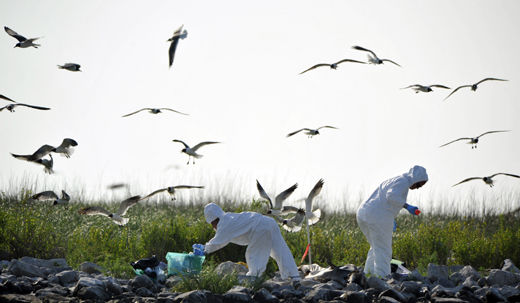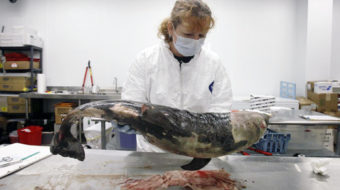
Seventy-seven days after oil from the destroyed Deepwater Horizon started gushing into the Gulf of Mexico, only a mere 67,000 barrels have been recovered. Far, far less than the 491,721 barrels a day BP said, in March, that it could skim off the water in the event of a spill. And far less than the estimated 4,000,000 barrels already discharged into the Gulf.
Louisiana union leaders, environmentalists and others are saying that the disparity between what BP told government regulators in March and what it has actually been able to do results from a willfully misleading manipulation of numbers by the company. The result, they say, has misled almost everyone, including government regulators, journalists covering the story and the public.
The first step in the numbers game, local officials claim, was a report BP issued in March that said it had the capacity to skim and remove 491,721 barrels of oil per day.
“The claims they filed with regulators back in March were never questioned by the government. No one checked to see if any of what the company was saying was true. BP never shared any information about any technology they had available to accomplish this. They didn’t show any pictures and no one in the media asked about any of their claims even weeks after the spill began,” said International Longshoremen’s Association Local 3000 Secretary-Treasurer Chris Hammond. His local represents New Orleans dock workers.
With as much as 4 million barrels discharged into the Gulf as of this week, the skimming operations have captured less than 900 barrels a day.
The second step in confusing matters came when, just days after the disaster, BP began lowering expectations. It issued releases that said it had a skimming capacity of “more than 171,000 barrels per day,” far less than the figure it had given the government only a month earlier.
The Sierra Club and a host of other environmental groups say that just as the company has been playing games with spill numbers, it can be expected to play games with numbers related to damage caused by the spill.
Environmentalists note that on Monday, the joint operations center for the federal government and BP said more than 671,428 barrels of an “oil-water mixture” had been reclaimed. Up until Monday journalists have been reporting the numbers as solid oil recovery figures. With BP now admitting that 90 percent of what has been recovered is water, the true amount of oil skimmed is the relatively small 67,000 barrels of oil.
Simple math calculations indicate that had the amounts in BP’s March response plan been accurate, 38 million barrels of oil could have been recovered by now – more than what most say is the total amount of the spill.
“This has been a cat and mouse game since March,” said Earthjustice attorney Colin Adams. “We want real figures instead of inflated estimates on what they are cleaning up and deflated estimates on how much is gushing out.”
There are new reports, meanwhile, of disturbing similarities between instances of company curbs on safety measures prior to the Gulf disaster, in which 11 were killed and prior to its 2005 Texas oil refinery explosion in which 15 were killed.
BP enacted major “cost savings,” a new report says, just before the earlier deadly explosion at its Texas City plant. The company cut inspectors and maintenance workers by the dozens to save just over $1 million, eliminated safety calendars for $40,000 in savings, eliminated safety shoes for workers to save $50,000 and eliminated safety awards to save $75,000.
Five years after the Texas City blast, a similar story of cutting costs to maximize profits has emerged from the current disaster in the Gulf.
Internal e-mails and reports obtained by the House Energy and Commerce Committee this week show that in the days before the Deepwater Horizon explosion BP made five critical choices to save money, even though it knew that the well had a severe gas flow problem. The report to Congress documenting this information was written by a Halliburton contractor responsible for cementing the well.
“This was after they decided, with the backing of the Bush administration in those years, to skimp on paying the $500,000 it would have cost to put in a simple shut-off valve,” said Robert “Tiger” Hammond, president of the Greater New Orleans AFL-CIO.
Photo: Fisheries biologist and conservation biologist for marine mammals obtain field samples from a severely decomposed Bottlenose dolphin on Queen Bess Island, La., May 26 Richard Alan Hannon/ The Advocate/AP












Comments